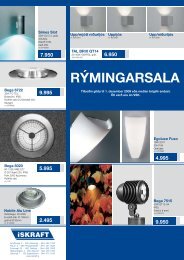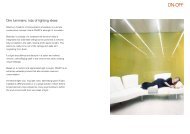- Page 1 and 2: 2005 - 2007 · Catalogue of Luminai
- Page 3 and 4: Catalogue of Luminaires 57 · 2005
- Page 5 and 6: 45° Wall luminaires Protection cla
- Page 7 and 8: GLASHÜTTE LIMBURG is part of a com
- Page 9: The raw materials react during the
- Page 13 and 14: We supply the metal parts for our l
- Page 15 and 16: · · · · · · · · · · · ·
- Page 17 and 18: · · · · · · · · · · 80 19
- Page 19 and 20: · · · · · · · · · · · ·
- Page 21 and 22: · · · · · · · · 190 250 300
- Page 23 and 24: · · · · · · · · 265 355 445
- Page 25 and 26: · · · · · · · · 230 320 410
- Page 27 and 28: · · · · · · · · · · 70 95
- Page 29 and 30: · · · · · · 140 185 220 · ·
- Page 31 and 32: · C · · A · · D · B · C · D
- Page 33 and 34: · C · · D · B· · A · C · D
- Page 35 and 36: · · · · · · 170 230 · 285 ·
- Page 37 and 38: · · · · · · · · · · 70 95
- Page 39 and 40: · C · · B · · A · Ceiling lum
- Page 41 and 42: 30° · C · · B · A · · Ceilin
- Page 43 and 44: · A · · B · · B · · A · Cei
- Page 45 and 46: · · · · · · 290 400 500 · B
- Page 47 and 48: · · · · · · 200 250 300 · C
- Page 49 and 50: · · · 45° · · · 200 250 300
- Page 51 and 52: · · · B · A · chrome brass whi
- Page 53 and 54: · · · · B · A · chrome brass
- Page 55 and 56: · · B · A · Ceiling luminaires
- Page 57 and 58: · · · · · · · · · · 290 3
- Page 59 and 60: · A · · B · Ceiling luminaires
- Page 61 and 62:
· · · · · · · · · · 270 3
- Page 63 and 64:
· · · · · · · · 440 560 670
- Page 65 and 66:
· · · Ceiling and wall luminaire
- Page 67 and 68:
· · · · · · · · · · 160 2
- Page 69 and 70:
· · · · B · A · · C · incan
- Page 71 and 72:
· · · · · · · · · · · ·
- Page 73 and 74:
· · · · · A · B Ceiling and w
- Page 75 and 76:
· · · · B · A · chrome brass
- Page 77 and 78:
· A · · B · · C · Ceiling and
- Page 79 and 80:
· A · B · · · C · Ceiling and
- Page 81 and 82:
· · B · A · · C · Ceiling and
- Page 83 and 84:
· · · · · · 210 260 320 · B
- Page 85 and 86:
· · · · A · · B matt alumin b
- Page 87 and 88:
B·· · · · A · B Ceiling and w
- Page 89 and 90:
· · · · · · · · · · · ·
- Page 91 and 92:
· · · · · · · · · · · 25
- Page 93 and 94:
· · · · · · · · · · · 22
- Page 95 and 96:
· · · · · · · · · · · ·
- Page 97 and 98:
· · · · · · · · · · · 22
- Page 99 and 100:
120° light aperture 160° adjustab
- Page 101 and 102:
· · · · 400 750 170° light ape
- Page 103 and 104:
180° light aperture 360° adjustab
- Page 105 and 106:
180° light aperture 360° adjustab
- Page 107 and 108:
· B · A · · · C · Wall lumina
- Page 109 and 110:
· · · · · · 260 300 400 · A
- Page 111 and 112:
· B · · A · · C· Wall luminai
- Page 113 and 114:
320 · A · · B · · C · Wall lu
- Page 115 and 116:
· · B B · · A · · C · · Sin
- Page 117 and 118:
· · 300 400 650 600 750 1200 ·
- Page 119 and 120:
· B · · A · · C· Wall luminai
- Page 121 and 122:
· 300 · 400 650 · · · · · ·
- Page 123 and 124:
· B · · A · · C · Wall lumina
- Page 125 and 126:
· · · 330 · 390 530 630 · ·
- Page 127 and 128:
· B · · A · · C· Wall and cei
- Page 129 and 130:
· · · · 245 · 340 · 430 · A
- Page 131 and 132:
· · · · 250 · 350 · 450 · A
- Page 133 and 134:
· B· · A · · C · Free-radiati
- Page 135 and 136:
· B· · A · · C · Enclosed wal
- Page 137 and 138:
· A · · B · · C · Wall lumina
- Page 139 and 140:
· A · · C · · B · Wall lumina
- Page 141 and 142:
· A · · C · · B · chrome bras
- Page 143 and 144:
·115· · 160 · · 185 · · B ·
- Page 145 and 146:
· A · · C · · B · Open wall l
- Page 147 and 148:
· A · · C · · B · Wall lumina
- Page 149 and 150:
· A · · C · · B · chrome bras
- Page 151 and 152:
· A · · B · · C· Wall luminai
- Page 153 and 154:
· A · · C · · B · Wall lumina
- Page 155 and 156:
· A · · B · · C · Enclosed wa
- Page 157 and 158:
· · · · · · 1100 900 500 · A
- Page 159 and 160:
· A · B· · · C · Wall luminai
- Page 161 and 162:
· · · · · · · · · · 700 6
- Page 163 and 164:
· · · · · · · · 600 500 400
- Page 165 and 166:
· · · · · · · · 510 410 310
- Page 167 and 168:
· 600 · · 500 · · 400 · · A
- Page 169 and 170:
· B· · A · · C · Wall luminai
- Page 171 and 172:
· · D · C · · · A · · B ·
- Page 173 and 174:
D · · · A · · C · · B · Wal
- Page 175 and 176:
· B · · A · · C · Wall lumina
- Page 177 and 178:
· B · · A · · C · Wall lumina
- Page 179 and 180:
· B · · A · · C · Wall lumina
- Page 181 and 182:
· · B · A · · C · Enclosed wa
- Page 183 and 184:
IP 44 · A · · B · Illuminated m
- Page 185 and 186:
· · · · · · 170 230 · 285 ·
- Page 187 and 188:
· 230 · 330 470 · · · · · ·
- Page 189 and 190:
· · · · · · 185 240 315 · L
- Page 191 and 192:
· 390 550 · · · · · 630 780
- Page 193 and 194:
·140· · 185 · · 220 · · L ·
- Page 195 and 196:
· 300 · 400 620 · · · · · ·
- Page 197 and 198:
· 610 710 1310 · · · · 670 770
- Page 199 and 200:
· A · · B · · L · · D C ·
- Page 201 and 202:
· · · · · · 80 110 · 140· 1
- Page 203 and 204:
· · · · · · 120 150 · 180 ·
- Page 205 and 206:
· L · B Pendant luminaires for
- Page 207 and 208:
Downlights · Pendant luminaires fo
- Page 209 and 210:
· · · 385 · 675 · 850 · · L
- Page 211 and 212:
· L · B · A · · · Pendant lum
- Page 213 and 214:
Pendant luminaires for • incandes
- Page 215 and 216:
· C· · B · · A· Pendant lumin
- Page 217 and 218:
· L · · A · Pendant luminaires
- Page 219 and 220:
A description of ceiling and wall l
- Page 221 and 222:
A description of ceiling and wall l
- Page 223 and 224:
· L · A · · B · · Pendant lum
- Page 225 and 226:
· 315 · 420 650 · · · · · L
- Page 227 and 228:
· · · · · · 95 ·105· 125 16
- Page 229 and 230:
· A · · B · Pendant luminaires
- Page 231 and 232:
· L · B Pendant luminaires für
- Page 233 and 234:
Pendant luminaires for • halogen
- Page 235 and 236:
· L · B · · · A · Pendant lum
- Page 237 and 238:
· A · · B · Pendant luminaires
- Page 239 and 240:
Pendant luminaires for • halogen
- Page 241 and 242:
· A · · B · · L · Pendant lum
- Page 243 and 244:
· · · · 210 · 300 · 360 · A
- Page 245 and 246:
Pendant luminaires for • incandes
- Page 247 and 248:
Variata 1 120° light aperture 160
- Page 249 and 250:
· C · · · A · 360° 360° B ·
- Page 251 and 252:
· B · · A · Table luminaires in
- Page 253 and 254:
· A · · B · Floor luminaires fo
- Page 255 and 256:
· B Table lamps for • incandesce
- Page 257 and 258:
· A · · B · Table lamps for •
- Page 259 and 260:
· A · · B · Floor lamp for •
- Page 261 and 262:
· B · A · · Floor lamp for •
- Page 263 and 264:
· B · A · · Table lamp for •
- Page 265 and 266:
· B · A · · Table lamps for •
- Page 267 and 268:
Distributor for 2 to 6 pendant lumi
- Page 269 and 270:
Protection classes · Safety classe
- Page 271 and 272:
Ballasts · Compensation All our lu
- Page 273 and 274:
symbol abbreviation wattage base lu
- Page 275 and 276:
* luminaires which our factory can
- Page 277 and 278:
* luminaires which our factory can

















